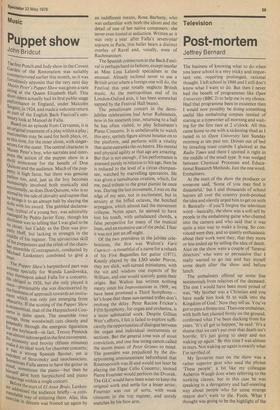Puppet show
John Bridcut Ti3e first Punch and Judy show in the Covent Garden of the Restoration was suitably r, `°11.nriemorated earlier this month, so it was fortuitously apposite that the very next day Master Peter's Puppet Show was given a rare airing at the short Opera actually had its first public stage Performance in England, under Malcolm Sargent, in 1924, and made a welcome return aS Part of the English Bach Festival's centenary look at Manuel de FaIla. Based on an episode from Cervantes, it is an original treatment of a play within a play; marionettes may be used for both plays, or, as this time, for the inner alone, with singer actors for the outer. The central character is Master Peter's boy, who narrates and interPrets the action of the puppet show in a ill monotone for the benefit of Don Quixote and the audience. Much of the pupPetrY is high farce, but there was genuine pathos too, and, just as the boy becomes Increasingly involved both musically and eill°tionally, so does Don Quixote, who is so shfirred k
n-1 the tale of chivalry and rapine that
rt!'rings it to an abrupt halt by slaying the olls with his sword. The gabbled declamaInn, typical of a young boy, was admirably ihanaged by Pedro Javier Ecay, though his shrillness was so telling that I was glad to be no closer. Ian Caddy as the Don was proPerlY bluff, but lacking in strength in the Middle of his register. The uproarious skill b°r the Puppeteers and the relish of the chammer. !nsemble (Contrapuncti, conducted by lennel Lankester) combined to give a w The P • uPpet Show's harpsichord part was Wk."en sPecially for Wanda Landowska, ,.'10 thereupon asked Falla for a concerto. _ue obliged in 1926, but she only played it ?.oce—Presumably she was disconcerted by freshness of approach towards an instruo—eht which was only just emerging from jsoseurity. If the scoring of the Puppet Show ceec0n°111ical, that of the Harpsichord Const rn .to p is quite spare. The ensemble (two 8s, three woodwind) cuts cleanly and or tninktedly through the energetic figuration vv e keYboard—in fact, Trevor Pinnock a_iinlost submerged in the first movement. mai."110n1Y and brevity (fifteen minutes) it Te it an ideal work for chamber concerts; redneal„! a strong Spanish flavour, yet is So --ht of Stravinsky and neoclassicism. rniMetin, „ —es Fal la seems to have the guitar in hin7A , sometimes the piano—but then he ren-dseir. gave both harpsichord and piano ileerings within a single concert. Interenaddr°drreet irart of El Amor Brujo, Lankesthe audience briefly—a comexer,....ahle way of enlisting them. Alas, this detente was frosted up again by an indifferent mezzo, Rosa Barbany, who was unfamiliar with both the idiom and the
detail of one of her native composers: she never even hinted at seduction. Written as it was only a year after Falla's seven-year sojourn in Paris, this ballet bears a distinct overlay of Ravel and, vocally, even of Rachmaninov.
The Spanish connection in the Bach Festival is perhaps hard to fathom, except insofar as Miss Liza Lalandi specialises in the unusual. Already inclined never to use a British artist where a foreign one will do, the Festival this year totally neglects British music. At the metropolitan end of its London-Oxford axis, it has been somewhat sapped by the Festival Hall beano.
The penultimate concert in the' demijubilee celebrations had Artur Rubinstein, now in his ninetieth year, returning to a hall he has often visited, to play Schumann's Piano Concerto. It is unbelievable to watch this spry, spritely figure almost bounce on to the platform, and perform with a vitality that quite outranks the orchestra. His mental and physical agility at that age are amazing. But that is not enough ; if his performance is assessed purely in relation to his age, then he is reduced to the level of a circus chimpan zee, watched by marvelling spectators. He was given a tumultuous ovation, which, for me, paid tribute to the great pianist he once was. During the last movement, I was on the edge of my seat, not in excitement, but in anxiety at the biffed octaves, the botched arpeggios, which almost had the movement collapse. Notes apart, he seemed to have lost his touch, with unbalanced chords, a false perspective for many of the musical lines, and an excessive use of the pedal. I fear it was not just an off-night. Of the two premieres in the jubilee celebrations, the first was Walton's Varii Capricci—a mouthful of a name for a rehash of his Five Bagatelles for guitar (1971). Keenly played by the LSO. under Previn, they are slick, well-turned miniatures, with the wit and wisdom one expects of Sir William, and one would scarcely guess their origin. But Walton has written nothing meaty since his Improvisations in 1969; we have been promised a Third Symphony_ let's hope that these sun-tanned trifles don't prolong the delay. Peter Racine Fricker's Fifth Symphony, for organ and orchestra, is a more substantial work. Despite Gillian Weir's efforts, I felt it failed to explore sufficiently the opportunities of dialogue between
the organ and individual instruments or sections. But the general tone was of stout conviction, and one fine string canon called the storm music of Peter Grimes to mind. The premiere was prejudiced by the disappointing announcement beforehand that Rostropovich was ill and would not later be playing the Elgar Cello Concerto; instead Pierre Fournier would perform the Dvorak. The GLC would have been wiser to keep the original work and settle for a lesser artist; Fournier was out of sorts, with weak climaxes , in the top register, and untidy snatches by his bow arm.


































 Previous page
Previous page